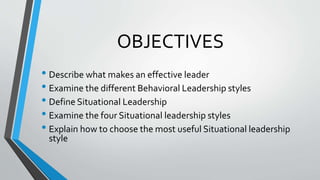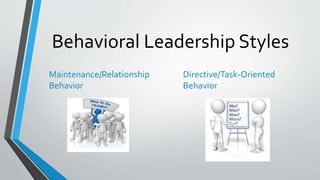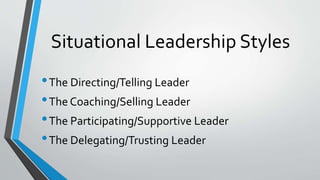How To Be An Effective Leader
- 1. HowTo Be An Effective Leader ŌĆ£Concept of LeadershipŌĆØ
- 2. OBJECTIVES ŌĆó Describe what makes an effective leader ŌĆó Examine the different Behavioral Leadership styles ŌĆó Define Situational Leadership ŌĆó Examine the four Situational leadership styles ŌĆó Explain how to choose the most useful Situational leadership style
- 3. What Makes a Leader? ŌĆó Knowledge and Understanding ŌĆó Skills and Ability to Communicate ŌĆó Teamwork ŌĆó Visioning ŌĆó RiskTaking ŌĆó Value in Others: Recognition and Encouragement
- 6. Situational Leadership Styles ŌĆóThe Directing/Telling Leader ŌĆóThe Coaching/Selling Leader ŌĆóThe Participating/Supportive Leader ŌĆóThe Delegating/Trusting Leader
- 8. ŌĆ£Coaching/SellingŌĆØ Leader YOU CAN DO IT!!! Great Job,Team!!!
- 11. ChoosingYour Situational Leadership Style ŌĆóKnowYour Group ŌĆóBe Aware ofYour Preferred Style ŌĆóBe Aware of How Others PerceiveYou ŌĆóPractice Moving from One Style to Another ŌĆóUse Behaviors Appropriate for that Style
- 13. (Recap) OBJECTIVES ŌĆó Describe what makes an effective leader ŌĆó Examine the different Behavioral Leadership styles ŌĆó Define Situational Leadership ŌĆó Examine the four Situational leadership styles ŌĆó Explain how to choose the most useful Situational leadership style
- 14. QUESTIONS?
Editor's Notes
- #3: ŌĆ£He or She is a Born LeaderŌĆØ Are all leaders born? Or can leadership be learned? Leadership can be learned. We all have leadership potential, just as we have some ability to sing or run. Some people may be better than others, but each of us has a starting point to build on with training and practice. Leadership is a process that helps a group to achieve its goals. Leaders and group members can mutually influence each otherŌĆÖs ideas. ŌĆ£The person who exhibits leadership isŌĆ”..someone that makes things happen that would not happen otherwise.ŌĆØ
- #4: Leaders should be well organized and have made time in their lives for their organization. Leadership requires commitment. Leadership is a mix of knowledge, values, skills and behaviors. A successful leader makes an effort to learn and practice skills. Some of the more essential components are: KNOWLEDGE AND UNDERSTANDING- general knowledge about the organization, how a meeting is run, and the organizationŌĆÖs business is essential. For example, an effective leader knows the purpose of the group or organization(why it exists), its goals(long term plan) and objectives (short term plans). An awareness of the subject that the group is involved with is very important. For example if you are a director of the Widget Association, you should know a little bit about widgets. SKILLS AND ABILITY TO COMMUNICATE- Good communicators can express themselves clearly and with confidence. However, a key and often forgotten component of effective communication is listening. A good listener hears not only the facts but also feelings. Paraphrasing is a useful technique. Ask one of them to explain what paraphrasing is? It helps with to clarify the message and it shows the speaker that you have heard what they have said. Successful leaders are great askers and they do pay attention. TEAMWORK- A leader cannot achieve success alone. An effective leader is involved and in touch with group members. He/She enables them to act by providing technical assistance, emotional support and vision. Effective leaders insist on the support and assistance of those affected by the project. They think in terms of ŌĆ£weŌĆØ not ŌĆśI.ŌĆØ VISIONING- A leader develops a vision of the organizationŌĆÖs future. It is important to communicate this vision to the members of the team, allowing them to respond and become a part of the visioning process. Visioning is a collaborative effort! Your team will grow and prosper by building commitment to a vision or dream that is shared by all. ŌĆ£Vision without action is merely a dream. Action without vision just passes time. Vision with action can change the world.ŌĆØ RISK TAKING- A leader is a risk taker and an innovator. A leader should recognize good ideas, actively support them and encourage action. Ask one of them to give an example of when they took a risk, like playing a sport? Leaders are learners and must be able to learn from their mistakes as well as their successes. So they must encourage their team members and support them through their mistakes. Without mistakes, there is no learning or growth. ŌĆ£Leaders are pioneers- people who are willing to step out into the unknown.ŌĆØ VALUE IN OTHERS: RECOGNITION AND ENCOURAGEMENT ŌĆō An effective leader must take the time to recognize and reward people for what theyŌĆÖve done. Individuals may become tired, bored or frustrated with a particular task or goal. They are often tempted to give up. A leader must provide the encouragement to motivate members to carry on. Recognition comes in many forms; given to individuals or groups, a word of encouragement ŌĆ£You did a great job, thanks.ŌĆØ Whatever the method give credit when credit is due. Always reward yourself as well. Celebrate once a goal or milestone has been accomplished. Showing a genuine concern and respect for your work, your team and community may be the best strategy in reaching your goal of outstanding leadership.
- #5: The willingness of a team relates to its attitude. If the team is willing, then it has confidence, commitment and motivation to accomplish specific job or activity. A leader who provides support and encouragement to a team is demonstrating a ŌĆ£maintenance or relationship behavior. Being able (or having ability) means that the team has the knowledge, skill and experience to accomplish a particular task. When a leader explains what each member is to do, as well as when, where, and how task or to be accomplished, he or she is demonstrating task-oriented behavior.
- #6: Situational leadership explains that the style a leader chooses depends mostly upon the teams level of readiness. How willing and able the members are to take responsibility as a team. It recognizes that the leader must be flexible and the team members are the most important factor
- #8: Unwilling and Unable Used when the team members are new or inexperienced and need a lot of help, direction, and encouragement in order to get the job done. Relationships within the team arenŌĆÖt explored to a great extent. The leader provides structure and guidance to the team. The leader defines the role of team members and directs them on what, how, when and where to do various tasls.
- #9: Willing but Unable The team is a little more responsible, experienced and willing. The leaderŌĆÖs main role is to assist team in doing a task for which they do not have the skills. The leader coaches the team through the skills of the task. Direction and guidance are necessary. Direction and guidance are necessary. The leader provides motivation to the team.
- #10: Unwilling but Able Knows the team has the ability to do the job. However, the team may be unwilling (apprehensive, bored, etc.) to start or complete the task. Team members and leader participate in making decisions and carrying them out together. Leader puts more emphasis on relationships and individuals feelings within the team. Team members feel important when the leader provides moral support and encouragement. Leader is a resource person and helper in this role.
- #11: Willing and Able Leader will choose to be a delegator team members are both willing and able to take responsibility for directing their own behavior. Leader trusts the team to do their own then and observes from a distance.
- #12: Important: no one style of leadership is appropriate for every occasion or situation! To be a good leader, know your group - "where they are at" in terms of their ability, knowledge, desire and willingness. In addition, you must be aware of your preferred style and how others perceive you. Be ready to adapt that leadership style to the occasion. Practise moving from one style to another, depending on the occasion. Use the behaviours appropriate for that style - they're easy to learn!
- #13: There is no secret recipe or magical formula to become an effective leader overnight. It is a process of trial and error, successes and failures. Never stop learning, and with practice you can increase your success in leadership! "The future will require those of us in such positions to keep our eyes, ears and minds open. It will require us to listen and to involve, to coach and to develop, to enrich and to motivate, to risk and to credit, to care and to express concern, and to laugh - especially at ourselves."
- #14: ŌĆ£He or She is a Born LeaderŌĆØ Are all leaders born? Or can leadership be learned? Leadership can be learned. We all have leadership potential, just as we have some ability to sing or run. Some people may be better than others, but each of us has a starting point to build on with training and practice. Leadership is a process that helps a group to achieve its goals. Leaders and group members can mutually influence each otherŌĆÖs ideas. ŌĆ£The person who exhibits leadership isŌĆ”..someone that makes things happen that would not happen otherwise.ŌĆØ














